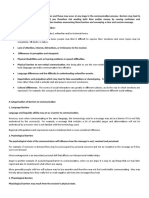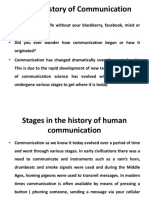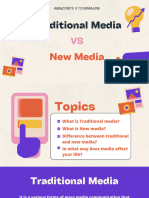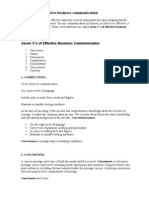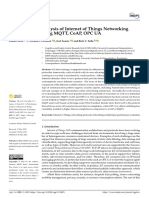Online Communication Tools
Online Communication Tools
Uploaded by
Moeed KhanCopyright:
Available Formats
Online Communication Tools
Online Communication Tools
Uploaded by
Moeed KhanCopyright
Available Formats
Share this document
Did you find this document useful?
Is this content inappropriate?
Copyright:
Available Formats
Online Communication Tools
Online Communication Tools
Uploaded by
Moeed KhanCopyright:
Available Formats
Online Communication tools
2. Online Communication tools:
Online communication refers to communication via networked computers. It encompasses synchronous communication (communication in real time via chat with all participants at their computers at the same time); asynchronous communication (communication in a delayed fashion by computer, such as e-mail); and the reading and writing of online documents via the World Wide Web. Online communication is a new phenomenon, having first come into existence toward the end of the 20th century. It is growing at one of the fastest rates of any new form of communication in human history. Online communication represents the most important development in human communication. The tools or ways used to communicate through internet are as follows:
2.1 Electronic Mail:
Electronic mail (email or e-mail) is a method of exchanging digital messages from an author to one or more recipients. Modern email operates across the Internet or other computer networks. Email systems are based on a store-and-forward model. Email servers accept, forward, deliver and store messages. Neither the users nor their computers are required to be online simultaneously; they need connection only, typically to an email server, for as long as it takes to send or receive messages.
2.1.1 Internet E-mail services
There are two ways to get e-mail over the Internet. One is by using an e-mail client program installed in the user's computer, and the other is Web-based e-mail accessible from a Web browser. Very often, mail can be sent and received on the same service via both e-mail client programs and web browsers.
1) The email client program- Tied to Computer:
The use of a mail program installed in the user's computer, such as Outlook, is often richer in features than web-based mail called an "e-mail client,"
2) Web-based E-Mail - From Any Computer:
Web e-mail means to use the program you have to browse it on the internet. The term also refers to a web e-mail service that is provided by a web e-mail provider for example Yahoo, Hotmail, and Gmail. The advantage of a webmail client is that you can access it anywhere where there is internet and you only need to browse the URL.
Internet - A new era of Communication
Page 5
Online Communication tools
2.1.2 E-mail address
An email address identifies an email box to which email messages are delivered. For example; nomanbadar@yahoo.com, themoeed@hotmail.com, m.nabeelashraf@live.co.uk Email address has three parts, which are as follows;
1) User name:
The first part is your username. You set up the username with your internet provider or e-mail service. It might be a form of your name or your nickname. Your service provider (Yahoo, Gmail) makes sure no one else on their system already has that name.
2) @ sign:
The second part of your e-mail address is @ (at) symbol.
3) Domain part:
The domain name appears after @ symbol and identifies the internet domain that handles your email. It can be further broken down into two parts: the name of the server that handles the e-mail (yahoo or hotmail) and the top-level domain, often "com," "gov" or "edu," which stand for commercial business, government agency and educational institution, respectively.
2.1.3 Parts of an e-mail message
A basic email message is made up of seven parts.
1) Recipients E-mail address:
The first thing in composing an email is the recipient's address. This is entered before composing the body of the email. This field is usually found in one of the spaces above the message. When sending a message to multiple recipients, be sure to separate all addresses with a comma.
2) Cc and Bcc:
Another option when sending a message to multiple recipients is to use the Carbon copy, and Blind carbon copy fields. When using the Cc feature, all recipients can see the email
Internet - A new era of Communication
Page 6
Online Communication tools
addresses of everyone the message was sent to. If you want your communication to be more private, choose the Bcc and the identities of the other recipients will not be shown.
3) Date and Time Stamp:
The date and time is usually included automatically somewhere in the message.
4) Subject Line:
The subject line is the first part of email that the recipient will see. When entering the subject line be sure to include important information such as what the email is about. If you don't include any subject line, your message could be mistaken for spam and deleted without being read.
5) Body:
The body is where you actually write the message. Message can be anything from a professional memo or a letter to friend or family member. Try to avoid writing too much. If you have a lot of information that needs to be sent includes it as an attached file.
6) Attachments:
Attachments are similar to enclosures in traditional mail. If you have files that you want to share with your recipient's you can include them as attachments to the email.
7) Signature:
Some email systems allow you to enter a signature that will appear automatically at the bottom of every message you send. This feature is optional.
2.1.4 Advantages of Email in Business
The advantages of email in business can be seen in small and large organizations.
1) Rapid Communication:
Email communications blaze through the internet with amazing speed. This speed allows businesses to work at a faster pace and communicate more effectively. Email can also be used to rapidly disseminate information to multiple employees at the same time.
2) Decreased Cost:
The biggest business advantage of using email is the cost savings. The overhead to maintain an email system is relatively low. Small businesses can utilize free online email
Internet - A new era of Communication
Page 7
Online Communication tools
services for no cost beyond their computer and internet connection expenses. The decreased costs for businesses can be seen in their postage usage, telephony expenses and even travel expenses.
3) Data Transfer:
Before email was available, the transfer of data was a time consuming and tedious task. Information was stored in large files or in large documents and then shipped to the place where data was needed. Now data transfer can occur rapidly, with little down time on information.
4) Security:
Email is a more secure method of communication than letters or faxes. Letters or faxes can be intercepted fairly easily at a business since a physical movement of the information must occur. Emails can create a record of the information in a safe environment that is easily backed up for future use.
5) Marketing:
Email marketing allows a business to reach customers in a more economical manner. Marketing and advertisements can be sent to a customer or a group of potential customers. This speedy dissemination of marketing materials increases sales and decreases the time between the start of a marketing campaign and customer purchases.
2.2 Online Chat:
The expression online chat comes from the word chat which means "informal conversation. Online chat refers to communication over the Internet that offers an instantaneous transmission of text-based messages from sender to receiver; hence the delay for visual access to the sent message shall not hamper the flow of communications in any of the directions. Online chat may address as well point-to-point communications as well as multicast communications from one sender to many receivers.
2.2.1 Types of online Chat
There are two types of online chat
1) Web Based Chat room:
The web based chat rooms (chat room or group chat) are actually virtual forums which allow the messages to be written and read by all of the individuals that exist in the
Internet - A new era of Communication
Page 8
Online Communication tools
internet room. Web-based chat rooms can be located throughout the internet on pages such as fan club websites, online gaming sites and personal websites, among others. Individuals can discuss a variety of topics, including computers, games, movies, music. Many popular search engines have their own chat platform and can be run under most operating systems, provided that the software that allows you to communicate with others in the chat room has been installed.
Advantages and Benefits of Chat room:
Chat rooms have been shown to have many benefits to different people since their inception.
y
Privacy is one of the most important advantages of chat rooms. You don't have to reveal your identity to others because you can use any available user name. Also, chat rooms are a place where people can judge you on thoughts and ideas rather than appearance. Chat rooms provide relaxed discussion in a stress-free environment. A person can find people all over the world to discuss subjects without being judged on how they look. A chat room with someone watching over the conversation and halting any harassment is a great way for individuals to connect without fear and let their beliefs is discussed openly. The chat room has been a way of creating study groups without the hassle of actually getting together. Entire classes can meet in a chat while sharing notes, discussing topics and giving opinions the may have held back in class for lack of time.
2) Real Time Chat:
Real-time chat or instant messaging offers users the ability to communicate in real time with individuals who have been added to a buddy list. Generally, the chat is centered on an actual conversation as opposed to a theme which would be found in a web-based chat room. Instant messaging is more private than a typical chat room, and it is a much faster and simpler way to communicate. Since instant messaging also allows users to communicate in real time, users can respond quickly to questions or comments. Instant messaging is a great way to stay in touch with family members and friends while saving money.
2.3 Blog:
A blog is a type of website or part of a website. Blogs are usually maintained by an individual with regular entries of commentary, descriptions of events, or other material such as graphics or video. Most blogs are interactive, allowing visitors to leave comments and even message each other and it is this interactivity that distinguishes them from other
Internet - A new era of Communication
Page 9
Online Communication tools
static websites. Many blogs provide commentary on a particular subject; others function as more personal online diaries. A typical blog combines text, images, and links to other blogs, web pages, and other media related to its topic. The ability of readers to leave comments in an interactive format is an important part of many blogs. Most important types of blog are art blog, photographs blog, video blog, music blog, political blogs, travel blogs, fashion blogs, project blogs, education blogs and legal blogs.
2.3.1 Corporate and organizational blogs:
Blogs used internally to enhance the communication and culture in a corporation or to communicate externally is called corporate blog. An internal blog, generally accessed through the corporation's intranet, is a blog that any employee can view. Internal blogs can be especially useful when the people involved are in different locations, or have conflicting schedules. Internal blogs may encourage employee participation, free discussion of issues, collective intelligence, direct communication between various layers of an organization and a sense of community. Corporate external blog are used for public relation tools. An external blog is a publicly available weblog where company employees, teams, or spokespersons share their views. It is often used to announce new products and services or the end of old products, to explain and clarify policies, or to react on public criticism on certain issues.
2.4 Internet Forum:
An internet forum is an online discussion place for trading ideas or information. An Internet forum allows people to post their queries and share their particular experiences, information, etc about products of the company, or any other topic. For example; there are many computer forums out there which, if you have a problem with your computer, you can look up that problem and you might find some other people who have been talking about that exact problem and how they are trying to solve it and potential solutions. A forum is an online communication between multiple users, generally through text-style communication. However, it differs from a blog, as a blog is usually written by one user and usually only allows for the responses of others to the blog material. An internet forum usually allows all members to make posts and start new topics. An internet forum is also different from a chat room. Members in a chat room usually all chat or communicate at the same time, while members in an internet forum post messages to be read by others whenever they happen to log on. Internet forums also tend to be more topic-focused than chat rooms.
Internet - A new era of Communication
Page 10
Online Communication tools
2.4.1 Structure of an internet forum:
A discussion forum is hierarchical or tree-like in structure: a forum can contain a number of sub forums, each of which may have several topics. Within a forum's topic, each new discussion or topic started is called a thread, and can be replied to by as many people as wish to. Depending on the forum's settings, users can be anonymous or have to register with the forum and then subsequently log in in order to post messages. On most forums, users do not have to log in to read existing messages.
2.4.2 Business Benefits of Internet forums
Some Benefits of internet forum are;
1) Free Knowledge:
In forums you have access to knowledge almost free. Forum members are ever willing to share their knowledge and experience with others and everyone can benefit from this free knowledge.
2) Mentorship:
Forum members provide a form of mentorship to new comers. There are people in every forum who are ever willing and ready to offer you help in any topic.
3) Opportunity to build credibility:
Forums offer you the opportunity to build credibility and establish yourself as prominent in the industry. If you offer help to people, you will soon be seen as an established expert in the industry. The idea here is for you to always be willing and ready to offer useful help to people.
4) Opportunity to advertise your products:
The forums have sections where you can advertise your products for free. This is also another way of saving you cost.
Internet - A new era of Communication
Page 11
Online Communication tools
2.5 Video Conferencing:
Video conferencing refers to real-time video and audio sessions, meetings and discussions between two or more users in two or more locations. Organizations with employees in multiple locations leverage advances and general ease of operations in video-conferencing technologies to engage with employees. Other businesses across domains and sectors are using this strategic communication tool more frequently.
2.5.1 Requirements for Video Conferencing:
A video-conferencing system comprises a camera, microphone and a compressed video system on dedicated bandwidth. This compressed video system allows smooth audio and video sessions via Voice over IP (Internet Protocol) lines or an ISDN (Integrated Services Digital Network) line. Large group meetings with many participants make use of multiple monitors and loudspeakers for video conferencing sessions.
2.5.2 What is VoIP Technology?
Voice over Internet Protocol (VoIP) is a family of technologies, communication protocols, or transmission techniques for the delivery of voice communications over internet. Other terms frequently used synonymously with VoIP are IP telephony, Internet telephony, voice over broadband (VoBB), broadband telephony, and broadband phone. VoIP technology has been enabling people to make voice and video calls over internet. This can cut the cost of calls, especially international calls, with VoIP providing inexpensive call rates between users of the same network.
2.5.3 Benefits of Video Conferencing
Video conferencing has emerged as one of the most effective tools of communication and strategic enablers in the Information Age. It can be used effectively in various scenarios and by varied industries, sectors and businesses and even in educational sector.
1) Cost saving:
Although business travel is unavoidable in some cases (you cant shake a hand yet with video conferencing), a great deal of business travel can be replaced with video conferencing. The cost savings can be tremendous. A tangible effect of using video conferencing is that you start saving substantial money due to reduced travel. In today's environment, where many employees are concerned with the safety and time-related issues with traveling, video conferencing will benefit your company in ways you would never have imagined.
Internet - A new era of Communication
Page 12
Online Communication tools
2) Increased Productivity:
Dispersed work forces and teams present many challenges, none more misunderstood than slow communication. Most teams communicate using phone, e-mail or instant messaging. However, most of the communications consist of non-verbal visual cues. Wherever video is added to a meeting, participants are more likely to stay focused, because they can be heard as well as seen. Expressions of satisfaction, concern, confusion, understanding and so on, can easily be seen and addressed, speeding and informing the group more effectively than emails, voicemails etc. The result: decisions are made faster, projects complete sooner, and productivity increased across organization.
3) Complicated Surgical Operations:
Doctors and attending physicians in high-tech medical centers can co-ordinate with their counterparts in specialty heath hospitals or clinics in other cities during complicated surgical operations and other medical emergencies. Videoconferencing makes it easier to access experts in a medical environment. Doctors, scientists and researchers, can bring together their findings and studies, and accelerate the process of providing timely assistance. This type of collaboration can not only help save lives, but can also help many people who can't travel distances to access health care.
4) Education:
Educational institutions, mainly long distance education programs and instructional courses, have reaped enormous benefits of video conferencing. Professionals and students are able to access lectures, study material, group discussions, and even a one-to-one talk with the instructor. Video conferencing has taken education into far flung corners of the world.
Internet - A new era of Communication
Page 13
You might also like
- Customer Pyramid: A Proven CRM StrategyDocument6 pagesCustomer Pyramid: A Proven CRM StrategyRolandas Medžiūnas50% (2)
- Pie Chart and Line GraphsDocument4 pagesPie Chart and Line GraphsMarlina Jeram SihombingNo ratings yet
- Features of Broadsheet NewspapersDocument6 pagesFeatures of Broadsheet NewspapersMinh HoangNo ratings yet
- Principles of Public RelationsDocument4 pagesPrinciples of Public RelationsSerunjogi Joshua Victor0% (2)
- Chapter 8 - Social MediaDocument10 pagesChapter 8 - Social Mediajoudaa alkordyNo ratings yet
- Personal or Social Letters Applications Formal or Business Letters Personal or Social Letters: Informal LettersDocument16 pagesPersonal or Social Letters Applications Formal or Business Letters Personal or Social Letters: Informal LettersHarsimar NarulaNo ratings yet
- Handout Text To MotionDocument3 pagesHandout Text To MotionMa Luisa Asma ParalejasNo ratings yet
- Module-3: Written CommunicationDocument106 pagesModule-3: Written CommunicationSURAJ GADAVENo ratings yet
- Email Marketing QuestionDocument3 pagesEmail Marketing QuestionSantosh ArakeriNo ratings yet
- Social Media (Autosaved)Document36 pagesSocial Media (Autosaved)Muhammad ZeeshanNo ratings yet
- Communication in The Digital AgeDocument10 pagesCommunication in The Digital AgeKean Brean GallosNo ratings yet
- Module 5 Communication Aids and Strategies Using Tools of TechnologyDocument6 pagesModule 5 Communication Aids and Strategies Using Tools of TechnologyTretasco CousinsNo ratings yet
- Pcic-Syllabus - Business Ventures in MultimediaDocument3 pagesPcic-Syllabus - Business Ventures in MultimediaSphencer John Cortes DeclaroNo ratings yet
- Customer Relationship Management - FormattedDocument26 pagesCustomer Relationship Management - FormattedMD. Samiul IslamNo ratings yet
- Multimedia: Multimedia. When You Provide A Structure of Linked Elements Through Which TheDocument10 pagesMultimedia: Multimedia. When You Provide A Structure of Linked Elements Through Which TheAruden ManisanNo ratings yet
- Facebook's PlatformDocument6 pagesFacebook's Platformtech2click100% (2)
- Lesson - 8, Wilbur Schramm ModeDocument9 pagesLesson - 8, Wilbur Schramm Moderupesh singhNo ratings yet
- The Components of An AdvertisementDocument5 pagesThe Components of An Advertisementlincy josephNo ratings yet
- Types of Social MediaDocument10 pagesTypes of Social MediaSoham JashuNo ratings yet
- Global Communication DefinitionDocument7 pagesGlobal Communication DefinitionMary Jane BadivalNo ratings yet
- Importance of Business CommunicationDocument7 pagesImportance of Business CommunicationfaazalwahabNo ratings yet
- Quiz #3 Purposive Communication: WCC North ManilaDocument3 pagesQuiz #3 Purposive Communication: WCC North Manilajoash suazoNo ratings yet
- Task 5 Broadcast Format Compilation Margen Sweet Brien A. BAB 1BDocument19 pagesTask 5 Broadcast Format Compilation Margen Sweet Brien A. BAB 1BJethro BoncodinNo ratings yet
- 2 - The Evolution of Public Relations PDFDocument9 pages2 - The Evolution of Public Relations PDFAndré Paz0% (1)
- Business Communication and Social Media ReportDocument37 pagesBusiness Communication and Social Media ReportUmme Hafsa100% (1)
- A Case Study On The Intercultural Communication Among Select Communication 10Document10 pagesA Case Study On The Intercultural Communication Among Select Communication 10Enrico Miguel AstrologoNo ratings yet
- Communication Skills - OdtDocument21 pagesCommunication Skills - OdtKashyap HiwseNo ratings yet
- Principles of Business CommunicationDocument3 pagesPrinciples of Business Communicationapi-224920675No ratings yet
- Graphic Design Full CourseDocument30 pagesGraphic Design Full Courseamenua.127No ratings yet
- Types of Social Media PDFDocument2 pagesTypes of Social Media PDFVaishali KhannaNo ratings yet
- Barriers To CommunicationDocument13 pagesBarriers To CommunicationJayesh GarachhNo ratings yet
- The Digital AgeDocument2 pagesThe Digital AgeAlejandro Lopez GonzalezNo ratings yet
- Module 4-Business Letters and Reports What Is A Business Letter?Document23 pagesModule 4-Business Letters and Reports What Is A Business Letter?CherianXavierNo ratings yet
- W11 - W13 Lesson 5 Communication For Work Purposes - Module ADocument5 pagesW11 - W13 Lesson 5 Communication For Work Purposes - Module AShadrach AlmineNo ratings yet
- Chapter 3 - Lesson 3 - Making InquiriesDocument27 pagesChapter 3 - Lesson 3 - Making InquiriesRica mae NarioNo ratings yet
- Lesson 1 (Mission-Vision)Document5 pagesLesson 1 (Mission-Vision)Patricia Erika ArgusNo ratings yet
- Chapter 7 SPR 2020Document44 pagesChapter 7 SPR 2020Nhan Doan Ngoc ThanhNo ratings yet
- 1.1) What Are Two Advantages of Using CMC in Your Everyday Life?Document4 pages1.1) What Are Two Advantages of Using CMC in Your Everyday Life?Jv ManuelNo ratings yet
- BusComm MidtermDocument93 pagesBusComm Midtermalyssa19calibara030% (1)
- Steps in Conducting Visual Rhetoric AnalysisDocument1 pageSteps in Conducting Visual Rhetoric AnalysisJj helterbrand100% (1)
- Multimedia at HomeDocument4 pagesMultimedia at HomeAhmad Azim HazimiNo ratings yet
- Lesson 4: Memorandum: Advantages of MemosDocument4 pagesLesson 4: Memorandum: Advantages of MemosJames Daryl TecsonNo ratings yet
- LESSON 6: Evaluating Messages and Images: Words and Pictures Can Communicate More Powerfully Than Either Alone.Document7 pagesLESSON 6: Evaluating Messages and Images: Words and Pictures Can Communicate More Powerfully Than Either Alone.Hazel Balasbas100% (1)
- A Brief History of CommunicationDocument15 pagesA Brief History of CommunicationPortugal Mark AndrewNo ratings yet
- Text Info MediaDocument27 pagesText Info MediaHarold CaponponNo ratings yet
- Palm OS (Also Known As Garnet OS) Is A Discontinued Mobile Operating System Initially DevelopedDocument17 pagesPalm OS (Also Known As Garnet OS) Is A Discontinued Mobile Operating System Initially DevelopedEssaki MuthuNo ratings yet
- Philippines - Media Landscape: July 2019Document39 pagesPhilippines - Media Landscape: July 2019Kynah AmorNo ratings yet
- Notes On Investigative JournalismDocument28 pagesNotes On Investigative JournalismbuytNo ratings yet
- AdvertorialsDocument3 pagesAdvertorialsShriyanshi Kashyap100% (1)
- The History of BroadcastingDocument2 pagesThe History of BroadcastingAlexie AlmohallasNo ratings yet
- 8 C'sDocument2 pages8 C'sMuhammed ZeeshanNo ratings yet
- Traditional MediaDocument15 pagesTraditional MediaAdrian Pacio100% (1)
- Business Letters FormatsDocument18 pagesBusiness Letters FormatsAlamdarabbas Jaffery100% (1)
- Computer Virus and Anti Virus 160219142022Document25 pagesComputer Virus and Anti Virus 160219142022AlkurdyNo ratings yet
- Week 7 - 063951Document28 pagesWeek 7 - 063951Jeniel CorrosNo ratings yet
- Resume ExampleDocument33 pagesResume ExampleShreyanshNo ratings yet
- One Step Flow TheoryDocument1 pageOne Step Flow TheorynazmahNo ratings yet
- Language and Media ReportDocument74 pagesLanguage and Media ReportPaula QuizanaNo ratings yet
- Effective Business CommunicationDocument20 pagesEffective Business CommunicationRushabh VoraNo ratings yet
- T2 - PP InglésDocument30 pagesT2 - PP InglésCÉSAR SÁEZ FARGALLONo ratings yet
- Dubai Islamic Bank Pakistan Internship ReportDocument19 pagesDubai Islamic Bank Pakistan Internship ReportMoeed Khan88% (8)
- In The Name of ALLAH, The Most Gracious, The Most Merciful: A Threat To EnvironmentDocument24 pagesIn The Name of ALLAH, The Most Gracious, The Most Merciful: A Threat To EnvironmentMoeed KhanNo ratings yet
- Types of TaxpayersDocument2 pagesTypes of TaxpayersMoeed KhanNo ratings yet
- Difference Between Letter and MemoDocument2 pagesDifference Between Letter and MemoMoeed Khan0% (1)
- 305158the Best Kept Secrets About InternetDocument4 pages305158the Best Kept Secrets About Interneti4tuuhk630No ratings yet
- RTK VRS - : 262 Receiver EZ Guide 500 FM 1000Document25 pagesRTK VRS - : 262 Receiver EZ Guide 500 FM 1000RevelinoNo ratings yet
- Altai A3-Ei Dual-Band 3X3 802.11ac Wifi Ap: Outdoor 802.11N/Ac, Built-In 2.4 GHZ and 5 GHZ Sector AntennasDocument2 pagesAltai A3-Ei Dual-Band 3X3 802.11ac Wifi Ap: Outdoor 802.11N/Ac, Built-In 2.4 GHZ and 5 GHZ Sector AntennasHendry MatosNo ratings yet
- Instructions Receiver TransmitterDocument4 pagesInstructions Receiver TransmitterRemy MendozaNo ratings yet
- Communication System Planning Lec 7Document27 pagesCommunication System Planning Lec 7fahad_shamshadNo ratings yet
- Error Pitstop Run Checker Figure PDFDocument2 pagesError Pitstop Run Checker Figure PDFEricNo ratings yet
- Best Computer Mcqs Over 1000 by MD Khalil UddinpdfDocument58 pagesBest Computer Mcqs Over 1000 by MD Khalil UddinpdfTuhin Azad100% (1)
- Dintek Catalogue Cat6 CableDocument2 pagesDintek Catalogue Cat6 CableMike ChewNo ratings yet
- Adopt Me!Document3 pagesAdopt Me!Palo Alto Homeless DogsNo ratings yet
- 7 Ways To Get A Free VPSDocument9 pages7 Ways To Get A Free VPSbaomuahe399100% (1)
- Composer Pro User Guide Rev WDocument586 pagesComposer Pro User Guide Rev WyossiatNo ratings yet
- Abbreviations of Networking Terms-IiDocument3 pagesAbbreviations of Networking Terms-IiSaniaNo ratings yet
- Computer Network Lab: Lab 3: Ipv4 Address SubnettingDocument21 pagesComputer Network Lab: Lab 3: Ipv4 Address SubnettingEng.sulNo ratings yet
- Key Features To Try in Your Kerio Control TrialDocument8 pagesKey Features To Try in Your Kerio Control Trialalan beugreNo ratings yet
- Listening and Speaking Getting ThroughDocument3 pagesListening and Speaking Getting ThroughNouha Sidi MoussaNo ratings yet
- RSID - Smart - 3G RO (3G in 2G) Main Remote - 4007 - General Luna Quezon - Rev - ADocument1,296 pagesRSID - Smart - 3G RO (3G in 2G) Main Remote - 4007 - General Luna Quezon - Rev - AJayson MasicatNo ratings yet
- Samba+Postfix With Ldap ServerDocument11 pagesSamba+Postfix With Ldap ServermanojgodiyalNo ratings yet
- Applied Sciences: A Performance Analysis of Internet of Things Networking Protocols: Evaluating MQTT, Coap, Opc UaDocument30 pagesApplied Sciences: A Performance Analysis of Internet of Things Networking Protocols: Evaluating MQTT, Coap, Opc UaLEE ALVAREZNo ratings yet
- Comptia Security Certification Practice Sy0 501Document457 pagesComptia Security Certification Practice Sy0 501anis100% (2)
- 2GIG Go!Control - Installation and Programming Guide (Archive)Document52 pages2GIG Go!Control - Installation and Programming Guide (Archive)Alarm Grid Home Security and Alarm MonitoringNo ratings yet
- Ebook DevOps ToolchainDocument11 pagesEbook DevOps ToolchainKalanidhiNo ratings yet
- 11E66919 A HAL2 User GuideDocument20 pages11E66919 A HAL2 User GuideElias SantosNo ratings yet
- UssdDocument3 pagesUssdAbhinav ChittibommaNo ratings yet
- Sis Web User Guide v3-5-1Document60 pagesSis Web User Guide v3-5-1Miguel RodriguezNo ratings yet
- Cheatsheet - Cheatsheet - Font Awesome PDFDocument8 pagesCheatsheet - Cheatsheet - Font Awesome PDFMarcus ViníciusNo ratings yet
- 华南X99 F8D主板说明书 11Document1 page华南X99 F8D主板说明书 11messiahsNo ratings yet
- DaaS Providers - GartnerDocument25 pagesDaaS Providers - GartnerGianpiere Salcedo MedinaNo ratings yet
- Vmware Vcloud Director: Install, Configure, Manage V9.XDocument2 pagesVmware Vcloud Director: Install, Configure, Manage V9.XMangesh AbnaveNo ratings yet
- "S.A.S.A.D.M.I.N. ", Superhero Exposed !!!: Fabian Robinson, Shiva Srinivasan PJM Interconnection, Norristown, PADocument6 pages"S.A.S.A.D.M.I.N. ", Superhero Exposed !!!: Fabian Robinson, Shiva Srinivasan PJM Interconnection, Norristown, PAPhuthuma Beauty SalonNo ratings yet
- Implementing Cisco Application Centric Infrastructure v1.0 (300-620)Document2 pagesImplementing Cisco Application Centric Infrastructure v1.0 (300-620)Aung TunNo ratings yet






























